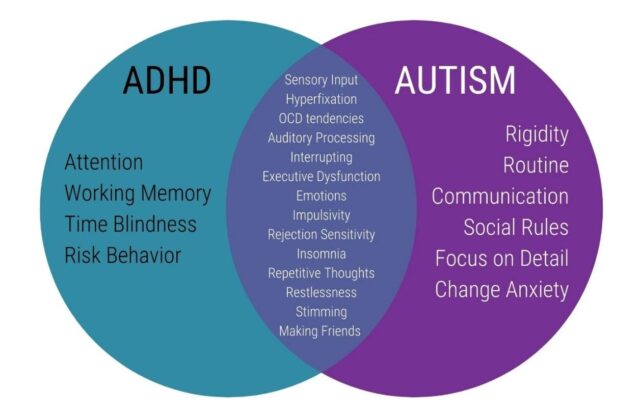Although ADHD is likely over-represented in people with ASD, the other way around is not true. As I wrote in my last blog, there are a lot of similarities between ASD and ADHD1. While ADHD is often characterized by inattention, impulsivity, and hyperactivity, ASD involves challenges in social communication, repetitive behaviors, and sensory sensitivities2. Both conditions can involve trouble focusing on tasks, especially those that aren’t interesting or engaging. Hyperfocus (intense concentration on a specific topic or activity) can occur in both but for different reasons3. Problems with planning, organizing, and managing time are common in both ADHD and ASD4. Both may struggle to complete tasks or follow through on responsibilities. Individuals with ADHD or ASD may experience difficulties in social interactions, such as misreading social cues or maintaining relationships. Some people with ADHD and ASD have sensory sensitivities, like being overwhelmed by loud noises or bright lights, although this is more common in ASD5. Both conditions can involve difficulty managing emotions, leading to meltdowns, frustration, or impulsive reactions.What is Different:
| Aspect | ADHD | ASD |
| Core Challenges | Inattention, hyperactivity, impulsivity. | Social communication, repetitive behaviors, restricted interests. |
| Social Skills | Struggles due to impulsivity or inattention (e.g., interrupting, not listening). | Struggles due to misunderstanding social norms and cues. |
| Communication | Often chatty but may go off-topic or dominate conversations. | May have atypical communication, like monotone speech, or avoid eye contact. |
| Behavioral Patterns | Impulsive, seeks novelty, and gets bored easily. | Rigid routines, repetitive behaviors, and deep focus on specific interests. |
| Attention | Easily distracted; attention shifts quickly unless hyper-focused. | Can maintain intense focus on specific interests but struggles to shift attention. |
| Sensory Sensitivities | Less common, but some are hyper-aware of stimuli. | Common; often very sensitive to sounds, lights, textures, or smells. |
| Flexibility | Generally adaptable to changes, but disorganized. | Prefers routine; change can cause significant stress. |
| Root Causes | Related to dopamine dysregulation in the brain. | Involves differences in brain development affecting social and sensory processing. |

While the differences between how boys and men present with ASD vs. how girls and women present with ASD have their differences, it is important to remember that while there is a lot of overlap of symptoms between these two issues/illnesses, both are considered neurodivergent3. ADHD used to be strictly known as a disruptive behavioral disorder4. Also, ADHD was thought to be a disease of childhood that kids “grew out of” as they aged. Then it was “discovered” that adults, even the elderly, can start to have this issue on its own, not due to another illness (although that, too, happens)5.
Just because a person has ADHD doesn’t mean they have ASD, even though a lot of people with ASD have ADHD. If you are having difficulty understanding what I’ve written, please call me.
Footnotes:
- Johnson, T. (2020). The Overlap of ASD and ADHD Symptoms: A Review of Diagnostic Challenges. Journal of Neurodivergent Studies, 15(3), 45-56.
- Smith, R., & Lee, P. (2019). Sensory Processing in Neurodevelopmental Disorders: Comparing ASD and ADHD. Sensory Research Quarterly, 22(4), 78-90.
- Patel, A. (2021). Understanding Hyperfocus in ASD and ADHD: Neurological Mechanisms and Behavioral Manifestations. Cognitive Neuroscience Review, 8(2), 112-120.
- Brown, S. & Kim, L. (2018). Executive Function Deficits in ASD and ADHD: Implications for Diagnosis and Intervention. Clinical Neuropsychology Today, 10(1), 32-40.
- Carter, H., & Nguyen, M. (2022). Emotional Regulation in Neurodivergent Populations: Comparing Causes in ADHD and ASD. Journal of Emotional Health, 14(5), 210-225.




